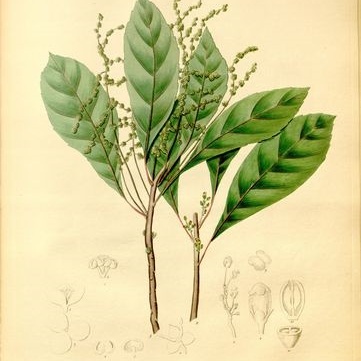Monoecious or dioecious trees or shrubs, quite glabrous or with an indumentum of simple or medifixed hairs. Leaves alternate or opposite, sometimes verticillate, petiolate (sometimes shortly so), stipulate, simple, entire or toothed, penninerved, with or without a pair of glands at the apex of the petiole. Inflorescences subterminal, axillary, lateral or leaf-opposed, solitary, pedunculate or sessile; ♂ inflorescences simple or compoundly spicate or racemiform; ♀ and hermaphrodite inflorescences shortly racemose or umbellate, or ♀ flowers sometimes solitary; bracts minute, biglandular or not at the base, directly subtending the glomerules or flowers, or with a short interval between them. Male flowers minute; calyx-lobes 3(–4), slightly imbricate to subvalvate at first, soon opening, thinly membranaceous, hyaline, each with 4 unequal concavities within; petals 0; disc 0; stamens 3(–4), opposite the calyx-lobes, ± free, filaments very short, anthers erect, basifixed, introrse, peltately 4-thecous, longitudinally dehiscent from the apex downwards on the inner face; pistillode columnar, clavate or 0. Female flowers pedicellate; sepals 3(–4), rarely 4–8, imbricate, herbaceous; petals 0, or rarely 3(–4); disc cupular, or composed of 3(–4) petaloid scales alternate with the sepals (and carpels when equal in number with them); ovary 2–3-locular, with 1 ovule per locule; styles 2–3, free or ± connate, short, flattened, dilated or bifid, spreading or adpressed to the top of the ovary. Fruit 2–3-locular, dehiscing septicidally into 2–3 bivalved cocci, or else loculicidally into 2–3 valves; exocarp smooth; endocarp thinly crustaceous; columella persistent. Seeds globose or ellipsoid, carunculate or not; sarcotesta thin, pigmented; endotesta foveolate, reticulate or echinulate, crustaceous; albumen fleshy; cotyledons broad, flat.
More
Trees or shrubs; dioecious (sometimes monoecious ?); branches with simple or malpighiaceous hairs. Leaves alternate; petioles usually with stalked glands; stipules glandular; blades pinnately veined, entire to dentate. Inftorescences axil-lary, 6' flowers in spiciform thyrses, 9 flowers in racemes (sometimes branched and paniculate). Staminate flowers sessile or subsessile; calyx-lobes 3, imbricate, ventrally ribbed; petals absent; disc absent; stamens 3, opposite the calyx-lobes, free, the filaments very short, the anthers extrorse, peltate, 4-loculate; pollen grains 3-colporate, intectate, psilate; pistillode small or obsolete. Pistillate flowers subsessile or pedicellate; calyx-lobes 3, imbricate; petals absent; disc cupuliform or dissected into 3 lobes; ovary of 2 or 3 carpels, ovules 1 per locule, the styles free, short, bifid, the style branches sometimes dilated. Fruits capsular, thin-walled; seeds rounded, ecarunculate, the outer seed-coat fleshy, the inner foveolate, endosperm present, the cotyledons broad, flat.

